We’ve covered my favorite trees and larger shrubs to attract birds; now I want to talk about some of the smaller plants to bring the birds and hummingbirds flying to your garden. These are just a few of my favorites to use as a starting point – there are so many gorgeous small shrubs, perennials, grasses and annuals to attract birds, it’d be impossible to cover them all!
Ornamental grasses provide winter seeds
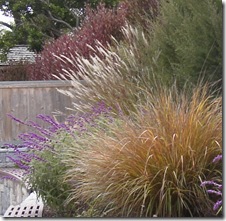 Most ornamental grasses, like Miscanthus, Pennisetum and Stipa, provide seeds to your neighborhood birds during the toughest time of the year – winter. The flower-plumes appear above the foliage in fall, and all winter you can watch the birds scratch at the soil for leftover seeds.
Most ornamental grasses, like Miscanthus, Pennisetum and Stipa, provide seeds to your neighborhood birds during the toughest time of the year – winter. The flower-plumes appear above the foliage in fall, and all winter you can watch the birds scratch at the soil for leftover seeds.
My favorite ornamental grasses for the birds?
Pennisetum alopecuroides ‘Moudry’ or Black-Flowering Fountain Grass, has unusual plumes which look great against plum-colored foliage plants.
Miscanthus transmorrisonensis or Evergreen Miscanthus is one of the prettiest and lowest-care grasses out there, with its reflective green year-round foliage and coppery purple plumes. This is the only Miscanthus I know of that needs zero winter pruning.
Stipa gigantea or Giant Feather Grass makes a bold statement near water features, boulders, or within a flowing perennial bed. The foliage only reaches 2’ tall, but the flowerheads can top 6’! I love the way the waving flowers bring a sense of motion to the garden.
Vaccinium ovatum and parvifolium or Evergreen Huckleberry and Red Huckleberry
What bird list would be complete without mention of our local birds’ favorite natives, the Huckleberries? The Red Huckleberry (V. parvifolium) is more beloved by the birds, but it’s also larger and more unruly than its relative, so I only suggest these in wilder settings.
The regular Evergreen Huckleberry, or V. ovatum, can hobnob with the best of your highly-bred garden beauties. The pretty red new growth and attractive habit make it easy to nestle in around Hydrangeas, Japanese Maples, and our native Flowering Currant.
The black berries are tart and make a great jam (with sugar!), but they’re such a pain to pick that the birds get them most years. They’ll get some size to them in time, but I’ve kept them around 3-4’ for many years with little effort.
Purple-leaved Weigela florida – spring nectar for hummingbirds
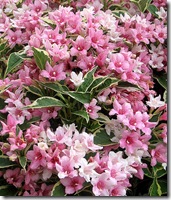 We’re all familiar with the old-fashioned Weigelas at left – but the last few years have brought us some really neat new purple-leaved varieties. All need full sun to stay purple, are deciduous, and have bright pink flowers in spring. From smallest to largest:
We’re all familiar with the old-fashioned Weigelas at left – but the last few years have brought us some really neat new purple-leaved varieties. All need full sun to stay purple, are deciduous, and have bright pink flowers in spring. From smallest to largest:
Weigela florida ‘Elvera’ or Midnight Wine Weigela has amazingly rich purple foliage. It gets to 2’ and has bright pink flowers in spring. I think they look especially cool with cream variegation or blue-toned foliage.
Weigela florida ‘Dark Horse’ or Dark Horse Weigela has a deep bronze color to its leaves. It’s a 3-footer, and that bronze color looks great with lush, interesting greens, like that Evergreen Miscanthus or with a Tree Fern in the (shady) backdrop.
Weigela florida ‘Java Red’ or Java Red Weigela is the largest and greenest of the group, but the color still makes a bold statement. Its foliage has a strong bronzey-purple cast, and it can reach 6’.
Sedum ‘Autumn Joy’, ‘Autumn Charm’, and ‘Autumn Fire’ or Hardy Stonecrop
Sedums have long been a staple of the low-care perennial garden, and no wonder – they bloom at the end of summer and early fall, when everything else is winding down, and their finished brown flowerheads go so nicely with the fall color and winter beiges. Not many plants are so graceful in death.
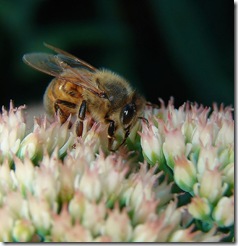 The reason I love them is that they feed such a variety of birds and insects! The honeybees come in droves and cling cheerfully to the flowers, and if the hummingbirds and butterflies can get in, they like the nectar too. In winter, the birds fly to the brown flowerheads and eat the seeds.
The reason I love them is that they feed such a variety of birds and insects! The honeybees come in droves and cling cheerfully to the flowers, and if the hummingbirds and butterflies can get in, they like the nectar too. In winter, the birds fly to the brown flowerheads and eat the seeds.
The honeybees are very gentle and have never stung me, even when I’ve brushed past quite roughly or had to prune off errant blooms, but I like to plant these guys at least five feet back from walkways just in case.
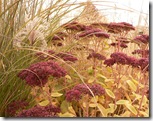 Sedum ‘Autumn Joy’ is the traditional one that looks so great with grasses and Black-eyed Susans, but it does have the tendency to flop with the first rains – not so good if you are leaving the brown seedheads into the winter for the birds.
Sedum ‘Autumn Joy’ is the traditional one that looks so great with grasses and Black-eyed Susans, but it does have the tendency to flop with the first rains – not so good if you are leaving the brown seedheads into the winter for the birds.
Sedum ‘Autumn Fire’ solves this problem with shorter, sturdier stalks, and the fading flowers are more coppery than brown, which is a bonus.
Sedum ‘Autumn Charm’ is a showy cream-variegated version which adds that extra season of spring/ summer foliage interest. It’s still a bit floppy, but you can fix that by pinching out all the growth tips in early summer (this works great for ‘Autumn Joy’ too).
Nigella damascena or Love-In-A-Mist
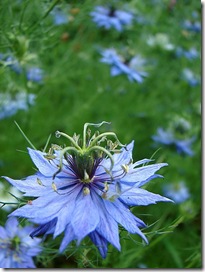 So, I don’t do many annuals. I like them in pots, and if I notice a bare spot as things go dormant I’ll tuck a few in, but as far as actually leaving bare garden space all winter while I wait for the annual’s season again? Not so much.
So, I don’t do many annuals. I like them in pots, and if I notice a bare spot as things go dormant I’ll tuck a few in, but as far as actually leaving bare garden space all winter while I wait for the annual’s season again? Not so much.
Nigella is my exception. I love the watercolor blues and purples of the traditional ones, and there’s also the gothy white one with blackish-burgundy centers – ‘African Bride’ or ‘White Bride’s Veil’, depending on your source. The plump, striped seed pods on all varieties add as much interest as the flowers!
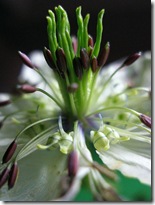 The birds snarf down my Nigella seeds all winter, but no matter – enough seeds sneak by that I have a lush crop every year.
The birds snarf down my Nigella seeds all winter, but no matter – enough seeds sneak by that I have a lush crop every year.
You can get Nigella in six-packs at the nursery, but why bother when they are so easy to grow from seed? Just sprinkle them someplace sunny in spring and leave them be.
(A note to adventurous eaters – Nigella damascena seeds aren’t the ones used in Indian and other ethnic types of cooking – that’s Nigella sativa – so leave the seeds for the birds!)
I hope this gives you some inspiration for your own bird garden. Stay tuned for the next installment – the best nectar plants for hummingbirds!
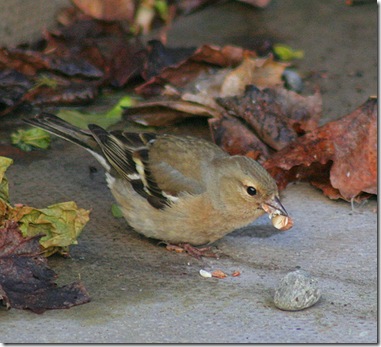
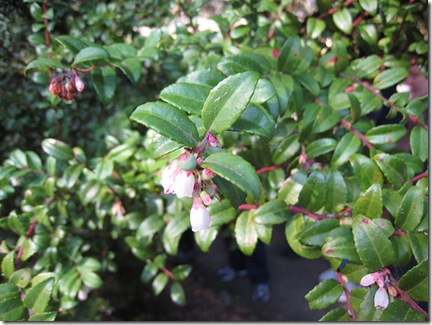
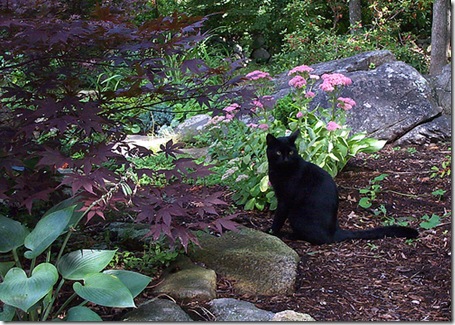
11 responses to “Smaller Plants to Attract Birds – a Few Favorites”
Great post, Genevieve ! I wonder which small plants in my garden attract birds. Would lantana count? The Bulbuls love its berries. And chillies! The Bulbuls love the ripe chillies too. What else? hmmm… you know I really have to look out more often.
I’m going to have to look for some of those new purple-leaved weigelas. I have a perfect spot for one.
Great post! It was for the birds 🙂
Aerie-el’s last blog post..RED, WHITE, AND GREEN
Very good post indeed. Very informative w/o the chattiness. I took some notes. Stopped by from Garden Muse.
Darla’s last blog post..What’s Going On In My Gardens Today?
Hi Gen
You know when I planned my garden I told the designer that I didn’t want any annuals (are we related????). I thought they were too fussy and too much work and I hated the idea of bare earth after they die. But even before your post, I started rethinking that notion. I have a no nonsense garden that lacks the sort of whimsy and delight that every garden needs to be fun and interesting. I’m starting to peek at those seed packets – I’m almost hooked and its all your fault. Amazing post as usual.
iona
Nigella is hot this year. I just ordered my seeds. I’ve enjoyed this series and the photos are beautiful. I do try to attract a lot of wildlife to my garden. I’m in the Monarch butterfly route and they are hungry when they arrive.
Anna/Flowergardengirl’s last blog post..Poor Truck, Ain’t It Pitiful
Hi Genevieve, what a little sweetie in that first photo! I love the black seeded grass, but it is quite a thug here with its seeds. I have it contained in an island bed surrounded by large pavement, driveway and the street that is has totally engulfed. That is okay but if it was in a regular flower bed it would have to go. Just a warning, I still love it and didn’t know about the birds liking the seeds either. Can you grow the red hot poker? Knifophia? The goldfinches sit on it all day picking out the seeds after and even during its bloom, kind of a fun plant too.
Frances
Frances’s last blog post..Hellebo-R-Us
Sunita, welcome! What a pleasure it was to see your beautiful blog. I am so taken with your butterfly post – the blue one who looks like a leaf – and the cashew photos! How neat!
LOL, thanks, Aerie-el! Glad you liked the Weigela.
Welcome, Darla – I just stopped by your blog for the first time and it’s so pretty! Love all the photos…
Iona, I know, isn’t it funny how we go from wanting things simple and with clean lines, to wishing for a bit more whimsy? With annuals come more maintenance, but if we choose wisely we can have the best of both worlds.
Anna, how lucky you are with your monarchs! I loved them dearly when I lived in San Francisco. I hope that Nigellas being the cool thing this year means we get some new varieties soon. I hope someone’s working on a burgundy one.
Frances, what a great suggestion with the hot pokers! We need really unusually good drainage to do them here, since we get so much rain, but when they work, they are gor-geous!!! I love the yellow ones in particular. Thanks for the tip on the goldfinches, I’ve only ever seen hummingbirds at the trumpets, so that’s wonderful to know.
Hi Genevieve.
That nigella caught my eye – I’ve been struck with a passion for blue varieties to plant this year. Miss Jekyll, Midnight. Any others to suggest?
The juncos and goldfinches were out first thing this morning in the snow storm. I ended up going out on the back porch in pj’s to sprinkle some more seed for them. Love these little ones. Great series. Thanks for sharing.
Ann
Ann’s last blog post..Garden Bloggers’ Muse Day March 1, 2009
I love any and all sedum (creeping, upright, greenish, reddish, yep!) and love in a mist. They really sow themselves. Hadn’t noticed birds eating the seeds, but glad they can. And who is your handsome cat friend with the sedum?
Hi! Genevieve — Your photos are beautiful and I espcially like your descriptions.
I noticed that you purchased Autumn Fire Sedum seeds. I can’t find a photo of the seeds. I have grown them and I don’t know what to save from the blossom for seeds. I belong to Davesgarden.com and I am surprised that no one on it has them. I really would appreciate it if you could describe what the seeds look like. Even better, if you have a photo of them you can send my way. Or if anyone else on this site can help me that would be wonerful!!! Thanks.
Hi Carol, I haven’t purchased Autumn Fire seeds, actually. I do know that all the sedums seem to reseed happily through the garden though, so if you can’t find seeds, consider just buying a plant and collecting seeds yourself by shaking the flowerheads into a bag around November-January. They are also very easy to root from cuttings or divide. You may need to check the tags of your Autumn Fire before propagating though as some varieties of plants aren’t legal to propagate – they are trademarked.
Here’s some info on that:
http://www.successwithseed.org/component/content/article/34-snips-and-sprouts/734-plant-patents-a-trademarks
Good luck to you!! They are awesome plants.